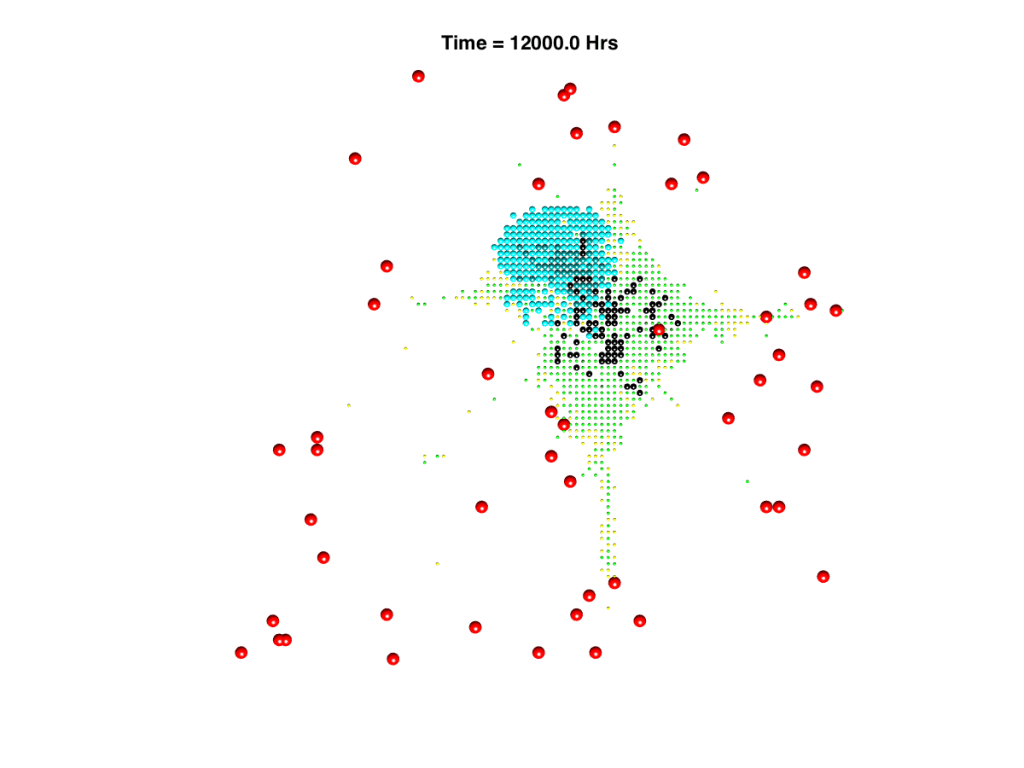I use mathematical modelling techniques to model infectious disease spread within the body. I use differential equations and individual-based models to mimic disease progression and simulate novel treatment strategies.
Tuberculosis (TB)
I am currently focused on modelling tuberculosis (TB) infection, with the aim of understanding more about disease relapse. With support from my Medical Research Council (MRC) fellowship, I will enhance the model to enable virtual testing of multiple antibiotics simultaneously, via an integrated pharmakokinetic/pharmcodynamic (PK/PD) model.

Schematic of population percentages of outcomes of TB disease
Although TB has long been preventable and curable, someone still dies from the disease somewhere in the world every eighteen seconds. In 2015 there were 480,000 new cases of multiple-drug-resistant (MDR) TB. Treatment is successful in approximately 50% of cases, and only 20% for extensively-drug-resistant (XDR) TB.


Example spatial plots from individual-based model. Left hand plot shows a concentration profile of oxygen supplied by the blood vessel network, right hand plot shows an example simulation outcome of a TB infection in a small area of the lung
Antimicrobial Resistance (AMR)
Resistance to antibiotics is one of the most imminent threats to public health worldwide. The World Health Organization has recognized antimicrobial resistance (AMR) as “a global health security threat that requires action across government sectors and society as a whole.” New resistance mechanisms are emerging and spreading, threatening our ability to treat common infectious diseases, resulting in prolonged illness, disability, and death. Without effective antimicrobials for prevention and treatment of infections, medical procedures such as organ transplantation, cancer chemotherapy, diabetes management and major surgery become very high risk. Infections that are currently simple to treat could be fatal. Furthermore, AMR increases the cost of health care and results in lengthier hospital stays.
UTIs are common infections that can be painful and uncomfortable, but usually pass quickly if treated with antibiotics. Enterobacteriaciae are the most common agents of UTIs. Recent years have witnessed the emergence of carbapenemase-producing Enterobacteriaceae (CPE). The threat of CPE is substantial as CPE can cause Enterobacteriaceae to become carbapenem resistance, which are currently the most common antibiotic prescribed for Enterobacteriaceae infections. Antibiotic treatment options for these multidrug-resistant infections are limited and clinicians are unclear as to whether combination or monotherapy antibiotic regimens are more effective. With my Academy of Medical Sciences (AMS) Springboard Award, I am currently supervising a PhD project in collaboration with colleagues at NHS Tayside to adapt the multiscale modelling and analysis framework, previously used to simulate TB, to study this other important infection.
COVID-19
The group and I have been using similar modelling techniques to try to understand more about this serious disease. Thanks to a Chief Scientific Office grant that we were awarded in 2020, my postdoc Chris Rowlatt and I have been working with our collaborators to develop a within-host mathematical model of SARS-CoV-2 infection. In 2021 I was awarded a RAMP Early Career Investigator Award for this work. See our new pre-print https://doi.org/10.1101/2022.05.06.490883 on our model. We’re also really excited that we have new funding from EPSRC to continue with this work.